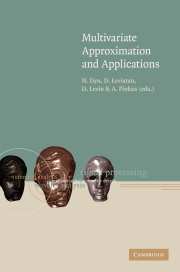Book contents
- Frontmatter
- Contents
- List of contributors
- Preface
- 1 Characterization and construction of radial basis functions
- 2 Approximation and interpolation with radial functions
- 3 Representing and analyzing scattered data on spheres
- 4 A survey on L2-approximation orders from shift-invariant spaces
- 5 Introduction to shift-invariant spaces. Linear independence
- 6 Theory and algorithms for nonuniform spline wavelets
- 7 Applied and computational aspects of nonlinear wavelet approximation
- 8 Subdivision, multiresolution and the construction of scalable algorithms in computer graphics
- 9 Mathematical methods in reverse engineering
- Index
9 - Mathematical methods in reverse engineering
Published online by Cambridge University Press: 06 July 2010
- Frontmatter
- Contents
- List of contributors
- Preface
- 1 Characterization and construction of radial basis functions
- 2 Approximation and interpolation with radial functions
- 3 Representing and analyzing scattered data on spheres
- 4 A survey on L2-approximation orders from shift-invariant spaces
- 5 Introduction to shift-invariant spaces. Linear independence
- 6 Theory and algorithms for nonuniform spline wavelets
- 7 Applied and computational aspects of nonlinear wavelet approximation
- 8 Subdivision, multiresolution and the construction of scalable algorithms in computer graphics
- 9 Mathematical methods in reverse engineering
- Index
Summary
Abstract
In many areas of industrial applications it is desirable to create a computer model of existing objects for which no such model is available. This process is called reverse engineering. In this chapter we will be concerned with reverse engineering of the shape of surfaces of objects. We will develop computer models which provide gains in efficiency of design, modification and manufacture. Reverse engineering typically starts with digitising an existing object. These discrete data must then be converted into smooth surface models.
Introduction
In the computer-assisted manufacturing process there often remain objects which are not originally described in a CAD-system. The reasons for this are:
modifications (grinding down or putting on of material) of existing parts, which are required in order to improve the quality of the product;
copying a part, when no original drawings are available;
real-scale clay or wood models which are needed as stylists and management often prefer real 3D objects for evaluation, rather than projections of objects on 2D screens at reduced scale.
These physical objects are measured by mechanical digitising machines or laser scanners or Moiré-based optical sensors. The resulting dataset may be partially ordered (digitising machines) or unorganised (laser scanners), and has to be transformed into smooth surfaces. As is mentioned in Varady et al. (1997) the main purpose of reverse engineering is to convert discrete datasets into piecewise smooth, continuous models.
- Type
- Chapter
- Information
- Multivariate Approximation and Applications , pp. 252 - 284Publisher: Cambridge University PressPrint publication year: 2001



